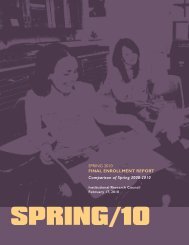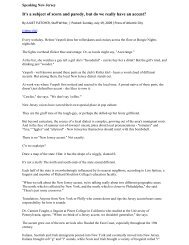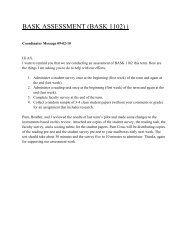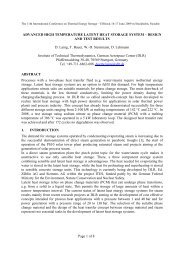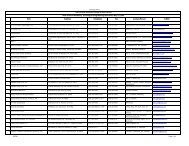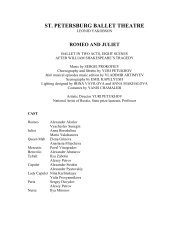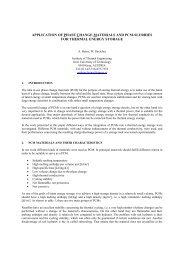activity newsletter06.pub - Richard Stockton College of New Jersey
activity newsletter06.pub - Richard Stockton College of New Jersey
activity newsletter06.pub - Richard Stockton College of New Jersey
You also want an ePaper? Increase the reach of your titles
YUMPU automatically turns print PDFs into web optimized ePapers that Google loves.
Kory Olson, Assistant Pr<strong>of</strong>essor <strong>of</strong> French6Kory Olson’s current research involves examining cartographic discourse (mapcolors, text, shapes, and symbols) on both <strong>of</strong>ficial and tourist guidebooks maps <strong>of</strong>Paris. He deals primarily with documents published during the first half <strong>of</strong> theFrench Third Republic (1870-1900). The nineteenth century was turbulent forFrance, with multiple revolutions, monarchies, empires, and republics. Byportraying its capital city on maps as calm, stable, and ready to accommodatevisitors and businessmen, the government hoped to eliminate the growing negativeimpression Paris, and France, had in Europe. Current projects include further archival research inParis expanding his map corpus into the 1930s, a period in which France countered the Europeantrend <strong>of</strong> voting for right-wing regimes with the election <strong>of</strong> their socialist Front Populairegovernment in 1936. He has presented recently on Third Republic maps at the 2006 NineteenthCentury French Studies Colloquium in Bloomington, IN and will present research on a 1930s mapat the 2007 Society <strong>of</strong> French Historical Studies in Houston, TX in March.Michael Lague, Assistant Pr<strong>of</strong>essor <strong>of</strong> BiologyMichael Lague is engaged in ongoing research into patterns <strong>of</strong> sex-based skeletal differences (i.e.,skeletal dimorphism) among living and fossil primates, including our early human ancestors. Hehas recently submitted a grant to the National Science Foundation (as co-PI) and is collaboratingon the proposed three-year project with colleagues from the University <strong>of</strong> Arkansas and TheGeorge Washington University. Using state-<strong>of</strong>-the-art technology for quantifying bone shape, thisproject will address problems specific to assessing dimorphism (and, by extension, social behavior)from fossil remains. Dr. Lague is also finalizing revisions for a paper on fossil human jaw bonesthat has been accepted by the Journal <strong>of</strong> Human Evolution; he is second author and was responsiblefor developing the statistical methods. In addition, Dr. Lague continues to work with a consortium<strong>of</strong> individuals centered at the University <strong>of</strong> Illinois on a set <strong>of</strong> projects involving the long-termeffects <strong>of</strong> lower limb joint injury on human gait patterns. During the summer, he was invited to aconference in Illinois to meet with participants and give a presentation on methodological issuesrelated to data collection and analysis.Scholarship <strong>New</strong>sPlan to take your classes to the Day <strong>of</strong> Scholarshipcelebrating and showcasing faculty, student & staff scholarly activitiesPresentations on March 1, 2007; West Quad, 8:30AM - 4:00PMInstitutional Review Board (IRB) at <strong>Stockton</strong>Reviews research involving human participants and meets on the first Monday <strong>of</strong> every monthAll investigators who are using human subjects are encouraged to follow a self-study trainingprogram and pass a brief exam before their projects will be reviewed by the IRB.You can access an on-line course at the site belowhttp://www.nihtraining.com/crtpub_508/index.html




